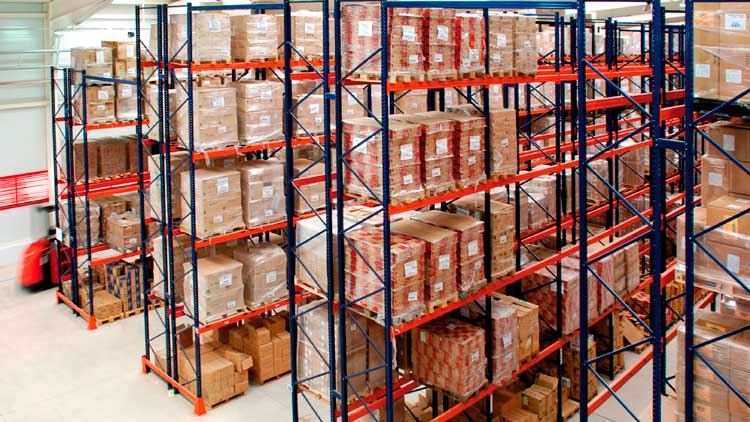Cantilever racking is a specially designed storage system designed to efficiently store long, bulky, or irregularly shaped items that are difficult or impossible to store on standard pallet racking. Its distinguishing feature is the absence of front-facing vertical columns, resulting in a completely open front.
The racking system is based on the working principle of a cantilever, a rigid structural element, similar to an arm, extending horizontally and supported only at one end.

Key Components & How It Works
A cantilever racking system consists of two main parts:
Upright Columns: These are vertical supports. They are usually made of heavy duty steel and have braces for stability. Each column has a base plate that is anchored to the concrete floor for safety.
Arms: These are horizontal supports extending from the columns. They are the “cantilever” part of the racking system. They can be adjusted vertically at different intervals along the columns and are typically tilted slightly upward (usually 1-2 degrees) to prevent items from sliding. Arms are typically installed in pairs (one on each side of the item), but can also be used individually for storing against a wall.
Wire Mesh Decking (Optional): Wire mesh decking, plywood, or particle board can be laid over the cantilever to create a shelving surface for smaller items.
The clever thing about this design is that the weight of the cargo is transferred directly to the upright columns through the cantilever, and the columns are designed to withstand this heavy moment-based pressure.
Advantages of Cantilever Racking
Unobstructed Access: This is the biggest advantage. The lack of a front column allows forklifts to access the load from any angle, making it incredibly easy to side-load long items like lumber, pipes, or sheet metal without having to maneuver around obstacles.
Ideal for Long/Bulky Items: Great for storing anything long, bulky, or that doesn’t fit on a pallet: lumber, PVC pipe, rebar, doors, sheet metal, furniture, carpet, fencing, and plastic extrusions.
Flexibility: The arms are easily adjustable and reconfigurable to accommodate items of different heights and lengths. You can create a custom storage layout for a variety of products.
High Density Storage: By storing items lengthwise, you can achieve very high storage density for long products.
Improved Safety & Visibility: The open design reduces the risk of a forklift hitting the front uprights while also improving inventory visibility.
Reduced Product Damage: Items can be stored without bending or restacking, and convenient access minimizes operational errors.
Cantilever Racking vs. Selective Pallet Racking
This is a crucial distinction. You would never use standard selective racking for the items a cantilever rack is designed for.
| Feature | Cantilever Racking | Selective Pallet Racking |
| Best For | Long, bulky, non-palletized items (lumber, pipes, furniture) | Uniform, palletized goods (boxes, cases, standard pallets) |
| Front Access | Completely open; no vertical obstructions | Vertical columns every few feet create obstructions |
| Loading Method | Side-loading (forklift approaches from the side) | Front-loading (forklift approaches from the front) |
| Structural Design | Arms are cantilevered from a strong central column | Beams are supported between two vertical columns |
Applications & Industries
* Cantilever racking is essential in industries that handle long or awkward materials:
* Lumber & Building Supply Yards
* Metal Fabrication & Steel Service Centers
* Plastics Industry (e.g., storing extrusions)
* Furniture Storage
* Window and Door Manufacturers
* Pipe, Tube, and Bar Storage
* HVAC Suppliers
* Landscaping & Fencing Supply
Important Considerations
Requires Expert Installation: The racking system must be carefully designed and anchored to the concrete floor to balance the heavy load on the extension arm. This is essential for safety.
Forklift Operator Skills: Operators need to be trained to place loads evenly on the paired fork arms to prevent tipping.
Not Suitable for Palletized Cargo: Cantilever racking is less efficient and more expensive for standard pallet storage than selective racking.
Conclusion
In short, cantilever racking is the optimal solution for storing long, bulky, or non-palletized items. Its open-front design provides accessibility and flexibility over traditional pallet racking. If your business handles materials like lumber, metal, or pipes, a cantilever system may be a necessary and efficient investment for your warehouse or yard.





